Frigidaire FGEF3058RWE, FGEF3058RWD, FGEF3058RWB, FGEF3058RWA, FGEF3058RFE Owner’s Manual
...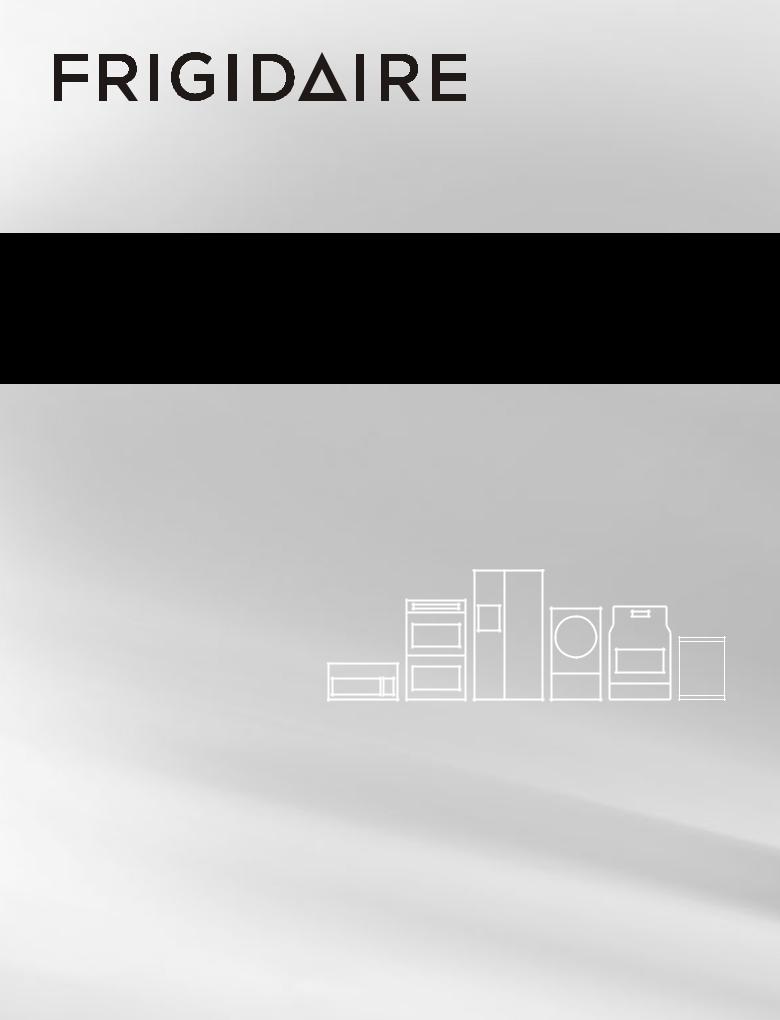
All about the
Use&Care
of your Electric Range
TA B L E O F C O N T E N T S
Important Safety Instructions........................... |
3-5 |
Before Setting Oven Controls............................ |
6-8 |
Before Setting Surface Controls....................... |
9-10 |
Setting Surface Controls .............................. |
11-14 |
Oven Control Functions (540 with probe)............ |
15 |
Setting Oven Controls.................................. |
16-31 |
Self-Cleaning............................................... |
32-34 |
Care & Cleaning .......................................... |
35-38 |
Before You Call............................................ |
39-43 |
Major Appliance Warranty...................... |
back cover |
www.frigidaire.com USA 1-800-944-9044 |
www.frigidaire.ca Canada 1-800-265-8352 |
2015) (March B Rev 316902222

PRODUCT RECORD AND REGISTRATION
Contents
Product Registration....................................................... |
|
2 |
Important Safety Instructions............................. |
|
3-5 |
Before Setting Oven Controls............................... |
|
6-8 |
Oven racks.............................................................. |
|
6-7 |
Effortless™ Oven Rack system and assembly................ |
|
8 |
Before Setting Surface Controls.......................... |
|
9-10 |
Cookware material types........................................... |
|
10 |
Setting Surface Controls................................... |
|
11-14 |
Single radiant elements............................................. |
|
11 |
Dual radiant element................................................. |
|
12 |
Keep warm............................................................... |
|
13 |
Home canning.......................................................... |
|
14 |
Oven Controls Functions........................................ |
|
15 |
Setting Oven Controls....................................... |
|
16-31 |
Setting the clock....................................................... |
|
16 |
Changing between 6-Hour Energy Saving feature |
|
|
or continuous bake setting........................................ |
|
16 |
Setting 12 or 24 hour display modes.......................... |
|
16 |
Changing oven temperature display mode.................. |
|
17 |
Setting for audible or silent keypad operation............. |
17 |
|
Setting oven lock...................................................... |
|
17 |
Timer....................................................................... |
|
18 |
Add a minute............................................................ |
|
18 |
Quick preheat........................................................... |
|
18 |
Bake........................................................................ |
|
19 |
Bake.time................................................................ |
|
19 |
Delay start............................................................... |
|
20 |
Convect bake............................................................ |
|
21 |
Convect roast........................................................... |
|
21 |
Convect broil (some models)..................................... |
|
22 |
Convect convert........................................................ |
|
22 |
Probe.................................................................. |
|
23-26 |
Broil......................................................................... |
|
27 |
Setting pizza feature................................................. |
|
28 |
Setting keep warm.................................................... |
|
28 |
Adjusting oven temperature....................................... |
|
29 |
Restoring to factory default settings........................... |
|
29 |
Operating oven light................................................. |
|
29 |
Setting the Sabbath mode feature......................... |
|
30-31 |
Self-Cleaning..................................................... |
|
32-34 |
Care & Cleaning................................................ |
|
35-38 |
Cleaning recommendation table................................. |
|
35 |
Cooktop maintenance and cleaning....................... |
|
36-37 |
Aluminum foil and oven liners.................................... |
|
37 |
Replacing the oven light............................................ |
|
37 |
Removing & replacing oven door................................ |
|
38 |
Before You Call - Solutions to common problems.. |
39-43 |
|
Appliance Warranty.................................. |
back cover |
|
Be sure to visit us online at |
|
|
www.frigidaire.com |
|
|
for a complete line of accessories. |
|
|
Thank you for choosing Frigidaire.
This Use & Care Guide is part of our commitment to customer satisfaction and product quality throughout the service life of your new appliance. We view your purchase as the beginning of a relationship. To ensure our ability to continue serving you, please use this page to record important product information.
Need help??
Visit the Frigidaire web site at www.frigidaire.com
Before you call for service, there are a few things you can do to help us serve your better.
Read this Use & Care manual.
It contains instructions to help you use and maintain your range properly.
If you received a damaged range ...
immediately contact the dealer (or builder) that sold you the range.
Save time and money.
Check the “Before You Call” list. This section helps step you through some common problems that might occur. If you do need service, help is only a phone call away. Call Frigidaire Customer Services at 1-800-944-9044.
Product Registration
Registering your product with Frigidaire enhances our ability to serve you. You can register online at www. frigidaire.com or by dropping your Product Registration Card in the mail.
Serial plate location
Serial plate location:  open storage drawer (some models) or remove lower front panel (some models).
open storage drawer (some models) or remove lower front panel (some models).
Record model & serial numbers here
Purchase date
Model number
Serial number
2 |
©2015 Electrolux Home Products, Inc. |
All rights reserved. Printed in the USA |
|

IMPORTANT SAFETY INSTRUCTIONS
Read all instructions before using this appliance.
Do not attempt to install or operate your appliance until you have read the safety precautions in this manual. Safety items throughout this manual are labeled with a WARNING or CAUTION statement based on the risk type.
Definitions
 This is the safety alert symbol. It is used to alert you to potential personal injury hazards. Obey all safety
This is the safety alert symbol. It is used to alert you to potential personal injury hazards. Obey all safety
messages that follow this symbol to avoid possible injury or death.
 WARNING
WARNING
WARNING indicates a potentially hazardous situation which, if not avoided, may result in death or serious injury.
 CAUTION
CAUTION
CAUTION indicates a potentially hazardous situation which, if not avoided, may result in minor or moderate injury.
 IMPORTANT
IMPORTANT
IMPORTANT indicates installation, operation, maintenance or valuable information that is not hazard related.
Important Safety Instructions
• Remove all tape and packaging before using the range. Destroy the carton and plastic bags after unpacking the range. Never allow children to play with packaging material.
• Proper installation—Be sure your appliance is properly installed and grounded by a qualified technician in accordance with the National Electrical Code ANSI/NFPA No. 70 latest edition and local electrical code requirements. Install only per installation instructions provided in the literature package for this range.
• User servicing—Do not repair or replace any part of the appliance unless specifically recommended in the manuals. All other servicing should be done only by a qualified technician. This may reduce the risk of personal injury and damage to the range.
Ask your dealer to recommend a qualified technician and an authorized repair service. Know how to disconnect the power to the range at the circuit breaker or fuse box in case of an emergency.
 WARNING
WARNING
Tip Over Hazard
•A child or adult can tip the range and be killed.
• Verify the anti-tip device has been installed to floor or wall.
•Ensure the anti-tip device is re-engaged when the range is moved to floor or wall.
•Do not operate the range without the anti-tip device in place and engaged.
•Failure to follow these instructions can result in death or serious burns to children and adults.
Range
leveling leg

 Anti-Tip bracket
Anti-Tip bracket
To check if the anti-tip bracket is installed properly, use both arms and grasp the rear edge of range back. Carefully attempt to tilt range forward. When properly installed, the range should not tilt forward.
Refer to the anti-tip bracket installation instructions supplied with your range for proper installation.
 WARNING
WARNING
•Stepping,leaningorsittingonthedoorordrawers of a range can result in serious injuries and also cause damage to the appliance. DO NOT allow
children to climb or play around the range. The weight of a child on an open oven door may cause the range to tip, resulting in serious burns or other injury.
•DO NOT LEAVE CHILDREN ALONE — to avoid injuries or burns children should not be left alone or unattended in the area where the range is in
use. They should never be allowed to sit or stand on any part of the range including the storage drawer, lower broiler drawer, lower oven or warmer drawer.
•To avoid a possible fire hazard, never use your appliance for warming or heating the room.
Save these instructions for future reference. |
3 |
|

IMPORTANT SAFETY INSTRUCTIONS
 WARNING
WARNING
•Storage in or on appliance — to avoid a fire hazard, flammable materials should not be stored in an oven, near surface units or in the storage drawer, warmer drawer or lower oven.
This includes paper, plastic and cloth items, such as cookbooks, plasticware and towels, as well as flammable liquids. Do not store explosives, such as aerosol cans, on or near the range.
•Protective liners—Do not use aluminum foil to line the oven bottom. Only use aluminum foil as
recommended in this manual. Improper installation of these liners may result in risk of electric shock, or fire.
 CAUTION
CAUTION
•Do not store items of interest to children in the cabinets above a range or on the backguard of the range. Children climbing on the range to reach items could be seriously injured.
•Do not touch surface heating units or surface cooking elements, areas near these units or elements, or interior surfaces of oven. Both
surface heating and oven heating elements may be hot even though they are dark in color. Areas near surface cooking units may become hot enough to cause burns. During and after use, do not touch, or let clothing or other flammable materials touch these areas until they have had sufficient time to cool. Among these areas are the cooktop, surfaces facing the cooktop, the oven vent openings and surfaces near these openings, oven door and oven door window.
•Wear proper apparel — loose-fitting or hanging garments should never be worn while using the appliance. Do not let clothing or other flammable materials contact hot surfaces.
•Do not use water or flour on grease fires — flour may be explosive. Smother the fire with a pan lid, or use baking soda, a dry chemical or foamtype extinguisher.
•When heating fat or grease, watch it closely. Fat or grease may catch fire if allowed to become too hot.
•Use dry potholders — moist or damp potholders on hot surfaces may result in burns from steam.
Do not let potholders touch hot heating elements. Do not use a towel or other bulky cloth instead of a potholder.
•Do not heat unopened food containers - buildup of pressure may cause container to burst and result in injury.
 IMPORTANT
IMPORTANT
Do not attempt to operate the range during a power failure. If the power fails, always turn off the range. If the range is not turned off and the power resumes, the range will begin to operate again. Once the power resumes, reset the clock and oven function.
•Be sure to always have an appropriate foam-type fire extinguisher available, visible and easily accessible located near the appliance.
•Never modify or alter the construction of a range by removing the leveling legs, panels, wire covers, anti-tip bracket/screws, or any other part of the range.
•Remove the oven door from any unused range if it is to be stored or discarded.
IMPORTANT INSTRUCTIONS FOR USING YOUR OVEN
•Use care when opening oven door , lower oven door or warmer drawer (if equipped)—Stand to the side of the range when opening the door of a hot
oven. Let hot air or steam escape before you remove or replace food in the oven.
•Keep oven vent ducts unobstructed. The oven vent is located under the left rear surface element if your model is equipped with coil elements. The oven vent
is located below the backguard for models equipped with ceramic-glass cook tops. Touching the surfaces in this area when the oven is operating may cause severe burns. Also, do not place plastic or heat-sensitive items on or near the oven vent. These items could melt or ignite.
•Placement of interior oven racks. Always place oven racks in desired location while oven is cool. If rack must be moved while oven is hot use extreme caution. Use potholders and grasp the rack with both hands
to reposition. Do not let potholders contact the hot heating elements in the oven. Remove all utensils from the rack before moving.
•Do not use the broiler pan without its insert. The broiler pan and its insert allow dripping fat to drain and be kept away from the high heat of the broiler. Do not cover the broiler insert with aluminum foil. Exposed fat and grease could ignite.
4

IMPORTANT SAFETY INSTRUCTIONS
SELF-CLEANING OVENS
 WARNING
WARNING
•Do not touch the oven during the self-clean cycle.
•Keep children away from oven during self-clean cycle.
•Failure to follow these instructions can result in burns.
•Clean in the self-cleaning cycle only the parts listed in this Use & Care Manual. Before selfcleaning the oven, remove the broiler pan and any utensils or foods from the oven.
•Do Not Use Oven Cleaners—No commercial oven cleaner or oven liner protective coating of any kind should be used in or around any part of the oven.
•Do Not Clean Door Gasket—The door gasket is essential for a good seal. Care should be taken not to rub, damage or move the gasket.
•The health of some birds is extremely sensitive to the fumes given off during the self-cleaning cycle of any range. Move birds to another well-ventilated room.
IMPORTANTINSTRUCTIONSFORCLEANING
YOUR RANGE
•Clean the range regularly to keep all parts free of grease that could catch fire. Pay particular attention to the area around each surface element. Do not allow grease to accumulate.
•Kitchen cleaners and aerosols—Always follow the manufacturer’s recommended directions for use.
Be aware that excess residue from cleaners and aerosols may ignite causing damage and injury.
•Clean ventilating hoods frequently—Grease should not be allowed to accumulate on the hood or filter. Follow the manufacturer’s instructions for cleaning hoods.
IMPORTANT INSTRUCTIONS FOR USING
YOUR COOKTOP
•Know which knob controls each surface heating unit. Place a pan of food on the unit before turning it on, and turn the unit off before removing the pan.
•Use proper pan size—This appliance is equipped with one or more surface units of different sizes. Select utensils having flat bottoms large enough to cover the surface unit heating element. The use of undersized utensils will expose a portion of the heating element to direct contact and may result in ignition of clothing. Proper relationship of utensil to element will also improve efficiency.
•Utensil handles should be turned inward and not extend over adjacent surface elements—To reduce the risk of burns, ignition of flammable materials, and spillage due to unintentional contact with the utensil, the handle of the utensil should be positioned so that
it is turned inward, and does not extend over adjacent surface units.
•Never leave surface elements unattended at high heat settings—Boilovers cause smoking and greasy spillovers that may ignite, or a pan that has boiled dry may melt.
•Do not immerse or soak removable heating elements—Heating elements should never be immersed in water. Heating elements clean themselves during normal operation.
•Glazed cooking utensils—Only certain types of glass, glass/ceramic, ceramic, earthenware, or other glazed utensils are suitable for cook top service without breaking due to the sudden change in temperature. Check the manufacturer’s recommendations for cook top use.
•When flaming foods under a ventilating hood, turn the fan on.
FOR CERAMIC-GLASS COOK TOP MODELS
•Do not cook on broken cook top—If cook top should break, cleaning solutions and spillovers may penetrate the broken cook top and create a risk of electric shock.
Contact a qualified technician immediately.
•Clean cook top with caution—If a wet sponge or cloth is used to wipe spills on a hot cooking area, be careful to avoid a steam burn. Some cleaners can produce noxious fumes if applied to a hot surface.
Important Safety Notice
The California Safe Drinking Water and Toxic Enforcement Act requires the Governor of California to publish a
list of substances known to the state to cause cancer, birth defects or other reproductive harm, and requires businesses to warn customers of potential exposure to such substances.
5
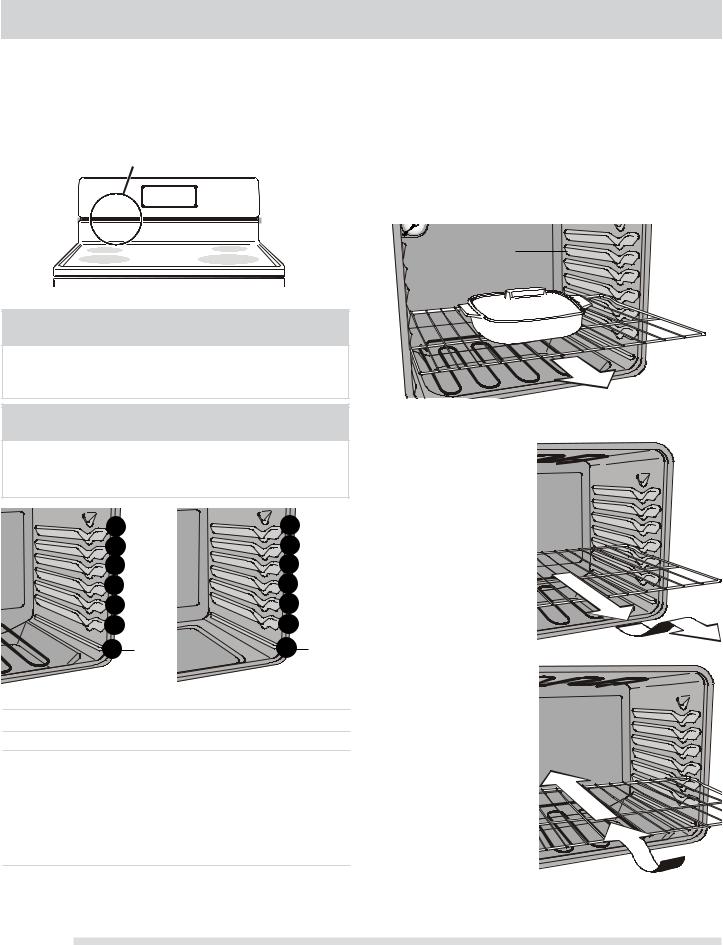
BEFORE SETTING OVEN CONTROLS
Oven vent location
The oven vent is located under the left side of the control panel (See Fig. 1). When the oven is heating, warm air passes through this vent. This venting is necessary for proper air circulation in the oven which helps to provide good baking results. Do not block the oven vent.
Fig. 1
Oven racks
 CAUTION
CAUTION
Always use oven mitts to protect hands from possible burns when using the oven or cooktop. The oven, oven racks and cooktop will become very hot.
 IMPORTANT
IMPORTANT
Do not remove or attempt to arrange oven racks with cookware still on the racks. To avoid damaging cookware or spilling food items, always remove any cookware first.
7 |
|
|
7 |
6 |
|
|
6 |
5 |
|
|
5 |
4 |
|
|
4 |
3 |
|
|
3 |
2 |
|
|
2 |
1 |
some |
|
1 some |
|
models |
|
models |
Oven with visible |
Fig. 2 |
Oven with hidden |
|
bake element |
Bake Element |
||
Recommended rack positions by food type |
|
||
Food type |
|
|
Position |
Broiling meats |
|
|
See broil |
Cookies, cakes, pies, biscuits & muffins |
4 or 5 |
||
Frozen pies, angel food cake, yeast, bread |
2 or 3 |
||
and casseroles |
|
|
|
Small cuts of meat or poultry |
|
2 or 3 |
|
Turkey, roast or ham |
|
|
1 or 2 |
Use only the offset oven (if equipped) rack if you choose to use rack position 7.
Oven rack stop
Most oven racks slide on rack guides provided along the oven cavity sides. The rack guides are curved near the front of each guide. The curve will catch and hold the oven rack stable into a stop position when an oven rack is extended straight out from the oven.
For better access to food items in the oven, slowly pull the oven rack straight out to the oven rack stop position (Fig. 3) before checking on food items or removing food dishes from the oven.
rack guides
Fig. 3
Removing, replacing & arranging most oven racks types
Arranging - always arrange oven racks when the oven is cool (prior to operating the oven).
To remove - |
Pull the |
oven rack straight out |
|
until it reaches the stop |
|
position.Tilt up front of |
|
oven rack to slide past |
|
the stop position and pull |
|
the rack out of the oven |
|
cavity (Fig. 4). |
Fig. 4 |
To replace - Rest the oven rack evenly between a left and right front guide along the oven walls so that the oven rack rests level. Tilt front of rack upward and slide rack in past the stop position. Then bring the rack to a level position and slide the rack completely inside oven (Fig. 5).
Fig. 5
6
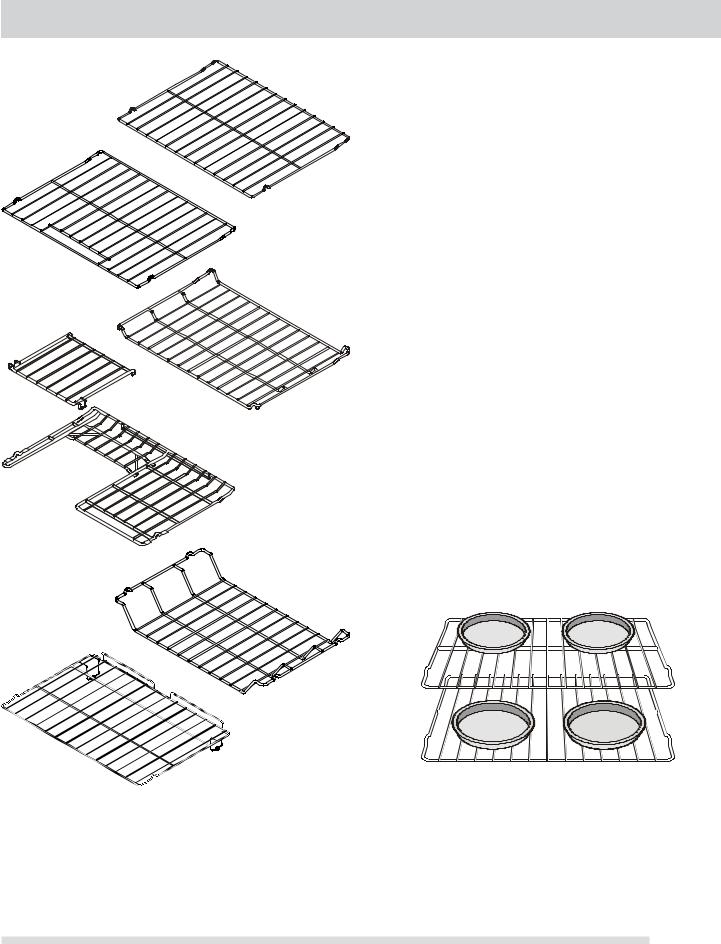
flat oven rack
flat |
offset |
|
handle |
||
oven rack |
||
oven rack |
||
(some |
||
(some models) |
||
models) |
||
|
half |
|
oven rack |
|
with |
bottom oven rack |
removable |
|
shelf (some models) |
(somemodels) |
Effortless™ Oven Rack
(some
models)
BEFORE SETTING OVEN CONTROLS
Types of oven racks
Your range may be equipped with one or more of the following oven rack types listed below:
The flat oven rack (some models) may be used for most cooking needs and may be placed in most rack positions.
The flat handle oven rack (some models) may be used for most cooking needs. May be placed in most rack positions. Similar to the flat oven rack but comes with a built-in handle.
The offset oven rack (some models) provides additional stepdown positions from the standard flat rack design.
The offset design positions the base of the rack about 1/2 of a rack position lower than the flat rack and may be used in most oven rack positions.
The half rack (some models) has a removable section to allow for taller cooking utensils in the oven. When the removable section is in place, the rack may be used like the flat oven rack.
The Effortless™ Oven Rack (some models) instructions are provided later in this section.
The bottom oven rack (if equipped) should only be used in the lowest oven rack position. To maximize oven space, place cookware on the bottom oven rack for example when roasting large cuts of meat. Do not use the bottom oven rack in any other oven rack position.
Air circulation in the oven
For best baking results allow 2 to 4 inches (5-10 cm) around the cookware for proper air circulation and be sure pans and cookware do not touch each other, the oven door, sides or back of the oven cavity. For even heating, hot air must be able to circulate freely around the pans and cookware (See Fig. 1).
Fig. 1
Baking layer cakes with 1 or 2 oven racks
For best results when baking cakes using 2 oven racks, place cookware on rack in positions 3 & 5. For best results when using a single or an offset oven rack, place cookware on rack in position 2, 3 or 4.
7
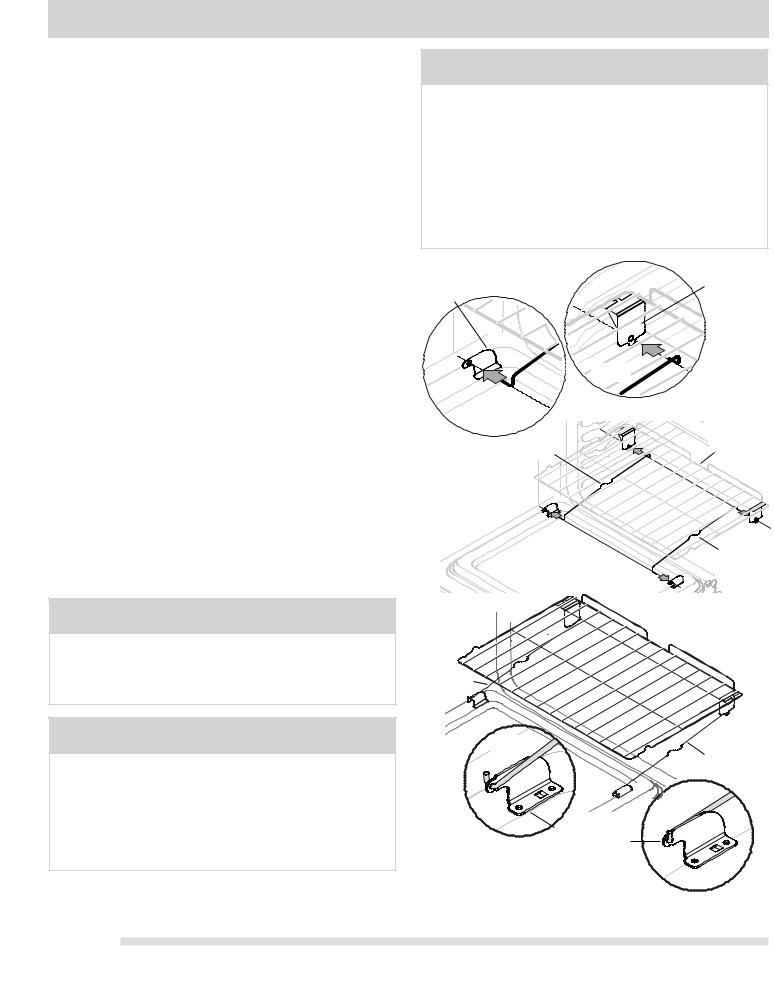
BEFORE SETTING OVEN CONTROLS
Effortless™ Oven Rack system (some models) Some models are equipped with a special oven rack system that automatically partially extends the oven rack from the interior oven glides to assist in easier access to your food items. This feature works whenever the oven door is opened or closed.
To assemble the Effortless™ Oven Rack system:
1.Locate all required parts. You will need the supplied oven rack (Effortless™ Oven Rack is a flat rack with a special dark coating on the left and right rack sides) and the 2 supplied chrome connector arms.
2.Open the oven door. Be sure the oven is completely cool before proceeding.
3.Place the oven rack in positions 2, 3 or 4 only. Be sure the rack connector brackets are at the rear of the range and pointing towards oven bottom (See Fig. 2).
4.Assemble one connector arm at a time. With the oven door open and the oven rack in place, install one end of the connector arm to the hole in the door connector bracket (Fig. 1) and the other end in the hole in the rack connector bracket (Fig. 2 and as in Fig. 3). The oven rack may need to be adjusted in or out in the rack position to match the length of the connector arm.
5.While holding the connector arm in place, twist the connector arm so the ends of the connector arm point upwards (See Figs. 4 & 5). The connector arm should now be locked into position.
6.Repeat steps 4 and 5 for the other connector arm.
7.Once both connector arms are properly in place, be sure to test the oven rack operation by gently closing the oven door. The oven rack should move in and out of the oven freely when the door is opened or closed.
 CAUTION
CAUTION
Never pick up hot oven rack parts. Make sure the oven and oven racks are COMPLETLY cool and safe to touch before attempting to assemble or disassemble the Effortless™ Oven Rack.
 IMPORTANT
IMPORTANT
Remove ALL oven racks and accessories before starting a self-clean cycle. If the oven racks are left in the oven during self-clean, the glide ability of the Effortless™ Oven Rack system will be damaged and will cause oven racks to loose their shiny finish. Remove ALL oven racks and clean according to instructions provided in the Care & Cleaning section of this manual.
8
 IMPORTANT
IMPORTANT
• Only the Effortless™ Oven Rack system should be used in oven rack position 2. Placing ANY other rack in oven rack position 2 will prevent the oven door from fully closing and may damage the oven door, oven cavity or the door connector brackets.
• If the rack system is not assembled with the connector arms the Effortless™ Oven rack may be used in oven rack positions 2 thru 6. Do not attempt to use the Effortless™ Oven rack in rack position 1.
door |
rack connector |
connector |
bracket |
bracket |
|
Fig. 1
connector arm
Fig. 3 - assembly of the Effortless™ Oven Rack
Fig. 2
oven rack
open oven |
connector |
door |
arm |
connector arm
Fig. 4
connector arm
 Fig. 5
Fig. 5
left and right door connector
brackets with connector
arm ends shown in locked position
(pointing upwards)
Fig. 6 - Effortless™ Oven Rack after assembly

BEFORE SETTING SURFACE CONTROLS
About the ceramic glass cooktop
Located under the surface of the glass ceramic cooktop are radiant surface elements. The design patterns on the ceramic cooktop outlines the area and size of the surface element. Be sure to match the pan size with the diameter of the element outline on the cooktop and use only quality flat-bottomed cookware.
The type and size of cookware, the number of surface elements in use and their settings are all factors that will affect the amount of heat that will spread to areas beyond the surface elements. The areas surrounding the elements may become hot enough to cause burns.
About the radiant surface elements
When activated, the element temperature rises gradually and evenly. As the temperature rises, the element will glow red. To maintain the selected power setting the element will cycle ON and OFF. The element will retain enough heat to provide a uniform and consistent heat during the off cycle.
For efficient cooking, turn the surface element OFF several minutes before cooking is complete. This will allow residual heat to complete the cooking process.
Element on & hot surface indicator lights
Your appliance is equipped with two different types of radiant surface control indicator lights that will glow on the backguard — the element on indicator lights and the hot surface indicator light (See Fig. 1).
The element on indicator lights are located on the control panel above each radiant element control knob and will glow when a surface element is turned ON. A quick glance at this indicator light after cooking is an easy check to be sure ALL surface controls are turned OFF. The hot surface indicator light located on the control panel will glow when any surface cooking area heats up and will remain on until the glass cooktop has cooled to a
MODERATE level.
element on |
hot surface |
indicator |
|
light |
indicator |
|
light |
Fig. 1
 NOTES
NOTES
•Radiant elements have a limiter that allows the element to cycle ON and OFF, even at the HI setting. This helps to prevent damage to the ceramic smoothtop. Cycling at the HI setting is normal and will occur more often if the cookware is too small for the radiant element or if the cookware bottom is not flat.
•Be sure to read the detailed instructions for ceramic glass cooktop cleaning in the Care & Cleaning and Before You Call checklist sections of this Use & Care Manual.
9
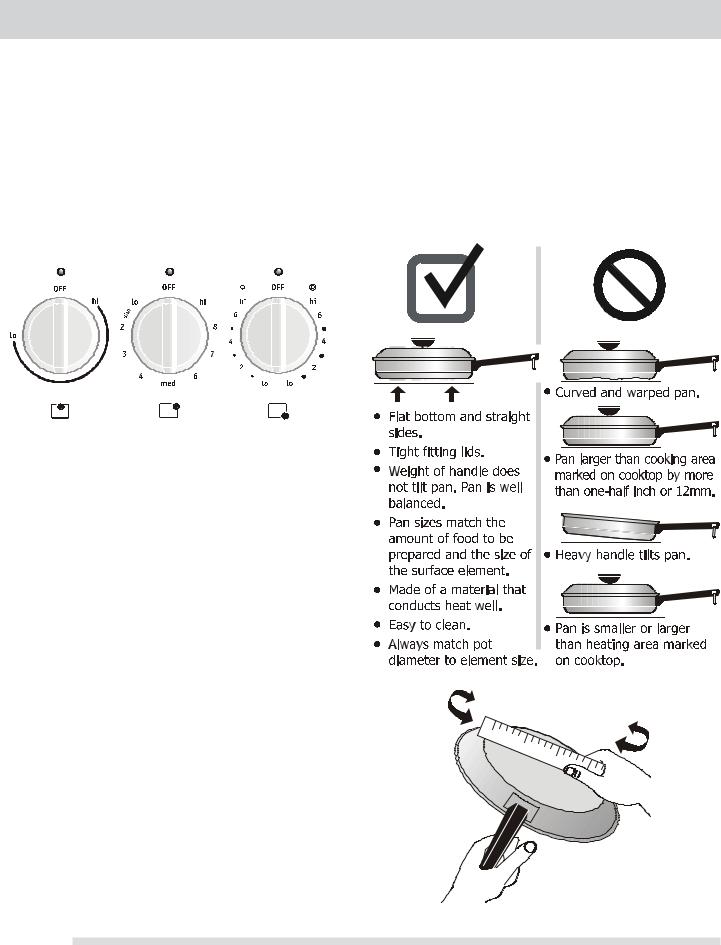
BEFORE SETTING SURFACE CONTROLS
Types of cooktop elements
Radiant surface elements are located just below the surface of the glass cooktop. The patterns on the ceramic glass outlines the size and type of element available at each position on the cooktop. The single radiant element will have a single round outline pattern shown.
The versatile dual radiant element will show with a dual ring pattern on the cooktop. This element allows the user to set the smaller inner portion as a single element or both inner and outer portions may be set to heat together (See Fig. 1).
Using proper cookware
The size and type of cookware used will influence the setting needed for best cooking results. Be sure to follow the recommendations for using proper cookware as illustrated in Figs. 2 & 3.
Cookware should have flat bottoms that make good contact with the entire element (See Fig. 2). Check for flatness by rotating a ruler across the bottom of the cookware (Fig. 3). For more information about the ceramic cooktop see “Cooktop Cleaning” and “Cooktop Maintenance” in the Care & Cleaning section.
|
|
|
|
|
|
|
|
|
|
|
|
|
|
|
|
|
|
|
|
|
|
|
|
|
|
|
|
|
|
Keep warm zone |
Single radiant |
Dual radiant |
|||
surface control |
surface control |
surface control |
|||
(some models) |
Fig. 1 |
(some models) |
|||
|
|
|
|
||
Cookware material types
The cookware material determines how evenly and quickly heat is transferred from the surface element to the pan bottom. The most popular materials available are:
Aluminum - Excellent heat conductor. Some types of food will cause it to darken (Anodized aluminum cookware resists staining & pitting). If aluminum pans slide across the ceramic cooktop, they may leave metal marks which will resemble scratches. Remove these marks immediately.
Copper - Excellent heat conductor but discolors easily. May leave metal marks on ceramic glass (see Aluminum).
Stainless - Slow heat conductor with uneven cooking results. Is durable, easy to clean and resists staining.
Cast Iron - A slow heat conductor however will retain heat very well. Cooks evenly once cooking temperature is reached. Not recommended for use on ceramic cooktops.
Porcelain-enamel on metal - Heating characteristics will vary depending on base material. Porcelain-enamel coating must be smooth to avoid scratching ceramic cooktops.
Glass - Slow heat conductor. Not recommended for ceramic cooktop surfaces because it may scratch the glass.
Fig. 2
Fig. 3
10

Suggested radiant surface element settings
The suggested surface element settings listed below are based when cooking with medium-weight aluminum pans with lids. Settings may vary when using other types of pans.
Suggested settings for single and dual radiant elements table
Settings |
Type of cooking |
High (HI - 9) |
Start most foods, bring water to |
|
a boil, pan broiling. |
Medium high (7 - 8) |
Continue a rapid boil, fry, deep |
|
fat fry. |
Medium (5 - 6) |
Maintain a slow boil, thicken sauces |
|
and gravies or steam vegetables. |
Medium Low (2 - 4) |
Keep foods cooking, poach, stew. |
Low (LO - 1) |
Keep warm, melt, simmer |
|
|
|
Fig. 1 |
 CAUTION
CAUTION
•Radiant surface elements may appear to have cooled after they have been turned off. The glass surface may still be hot and burns may occur if the glass surface is touched before it has cooled sufficiently.
•Do not place flammable items such as plastic salt and pepper shakers, spoon holders or plastic wrappings on top of the range when it is in use.
These items could melt or ignite. Potholders, towels or wooden spoons could catch fire if placed too close to the surface elements.
SETTING SURFACE CONTROLS
Single radiant surface elements (all models)
Fig. 2
To operate a single radiant element:
1.Place correctly sized cookware on single radiant surface element.
2.Push in and turn the surface control knob in either direction (Fig. 2) to the desired setting (Refer to the
Suggested radiant surface element settings table Fig. 1).
3.When cooking is complete, turn the radiant surface element OFF before removing the cookware.
Start most cooking operations on a higher setting and then turn to a lower setting to finish cooking. The surface control knobs do not have to be set exactly on a particular spot. Use the graphics provided as a guide and adjust the control knob as needed. Each surface element provides
a constant amount of heat at each setting. A glowing red surface heating area extending beyond the bottom edge of the cookware indicates the cookware is too small for the surface heating area.
 IMPORTANT
IMPORTANT
Do not allow aluminum foil, or ANY material that can melt to make contact with the ceramic glass cooktop. If these items melt on the cooktop they will damage the ceramic cooktop.
NOTES
•The size and type of utensil used, and the amount and type of food being cooked will influence the setting needed for best cooking results.
•The element on indicator lights will glow when one or more elements are turned ON. A quick glance at these indicator lights when cooking is finished is an easy check to be sure all control knobs are turned OFF. The hot surface indicator light will continue to glow AFTER the control knob is turned to the OFF position and will glow until the heating surface area has cooled sufficiently.
11
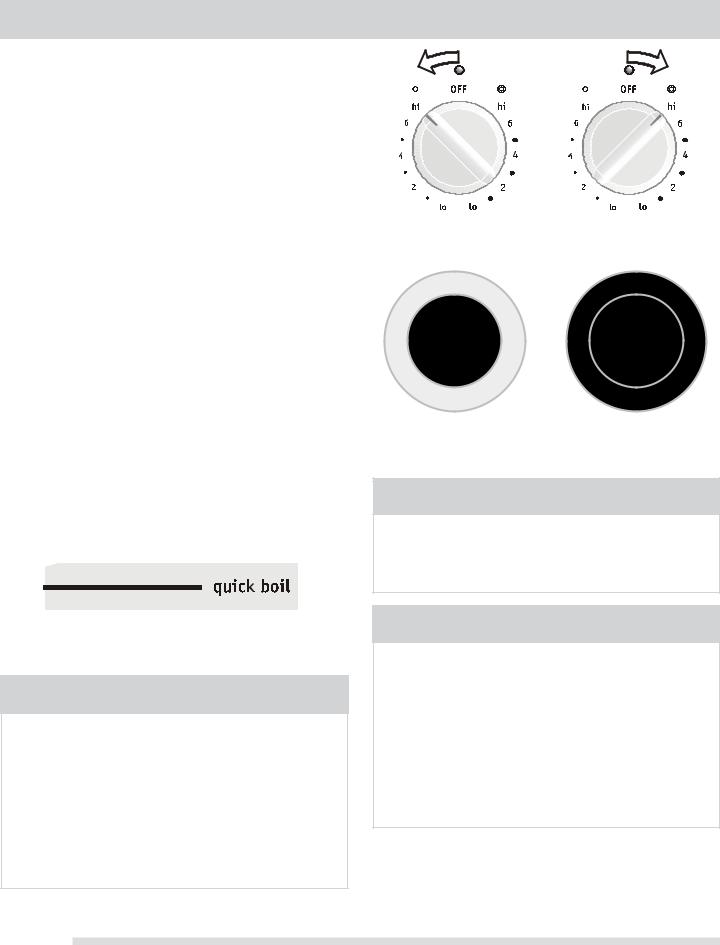
SETTING SURFACE CONTROLS
Dual radiant surface elements (some models)
Symbols provided on the backguard graphics will indicate which coil of the dual radiant element will heat. The
 symbol indicates the inner coil only. The
symbol indicates the inner coil only. The  symbol indicates both inner and outer coils will heat.
symbol indicates both inner and outer coils will heat.
To operate a dual radiant element:
1.Place correctly sized cookware on dual radiant surface element.
2.If only the inner heating portion is needed, push in and turn the knob counter-clockwise to start (Fig. 1). Push in and turn the surface control knob clockwise to when heating both the inner and outer (Fig. 2) portions of the dual element together.
3.When finished cooking, turn the dual radiant surface element OFF before removing the cookware.
You may switch from either coil setting at any time during cooking. See Suggested radiant surface element settings table on previous page.
Start most cooking operations on a higher setting and then turn to a lower setting to finish cooking. The surface control knobs do not have to be set exactly on a particular mark. Use the marks as a guide and adjust the control knob as needed. A glowing red surface heating area extending beyond the bottom edge of the cookware indicates the cookware is too small for the surface heating area.
Quick boil feature (some models)
Your appliance may be equipped with one or two elements on the ceramic cooktop marked quick boil.
These radiant elements are best used when bringing larger quantities of liquid to temperature and when preparing larger quantities of food.
 CAUTION
CAUTION
•Radiant surface elements may appear to have cooled after they have been turned off. The glass surface may still be hot and burns may occur if the glass surface is touched before it has cooled sufficiently.
•Do not place flammable items such as plastic salt and pepper shakers, spoon holders or plastic wrappings on top of the range when it is in use.
These items could melt or ignite. Potholders, towels or wooden spoons could catch fire if placed too close to the surface elements.
|
|
|
|
|
|
|
|
|
|
|
|
|
|
|
|
|
|
|
Heating with both |
|
|
Heating with inner (small) |
|
|
|||
|
element only |
|
|
elements |
||
|
|
|
|
|
|
|
|
|
|
|
|
|
|
Areas that heat are shown darkened.
Fig. 1 |
Fig. 2 |
 IMPORTANT
IMPORTANT
Do not allow aluminum foil, or ANY material that can melt to make contact with the ceramic glass cooktop. If these items melt on the cooktop they will damage the ceramic cooktop.
 NOTES
NOTES
•The size and type of utensil used, and the amount and type of food being cooked will influence the setting needed for best cooking results.
•The element on indicator lights will glow when one or more elements are turned ON. A quick glance at these indicator lights when cooking is finished is an easy check to be sure all control knobs are turned OFF. The hot surface indicator light will continue to glow AFTER the control knob is turned to the OFF position and will glow until the heating surface area has cooled sufficiently.
12
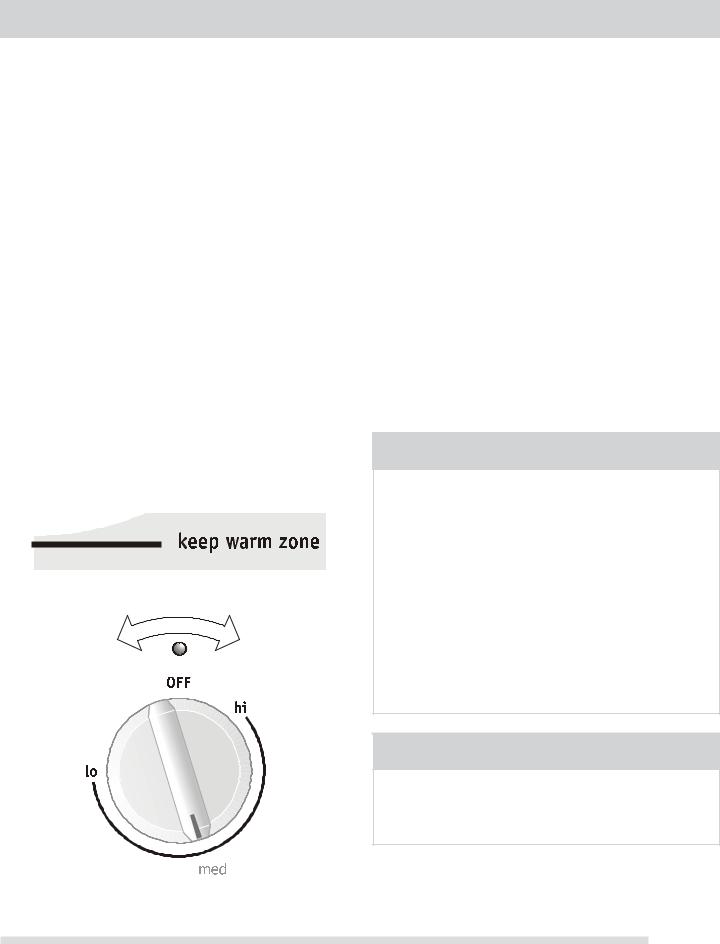
Keep warm (some models)
The purpose of the keep warm zone is to keep hot cooked foods at serving temperature. Use the keep warm feature to keep cooked foods hot such as; vegetables, gravies, casseroles, soups, stews, breads, pastries and oven-safe dinner plates.
Always start with hot food. It is not recommended to heat cold food on the keep warm zone. All food placed on the warming zone should be covered with a lid to maintain quality.
For best results, when warming pastries or breads, the cover should have an opening to allow moisture to escape.
Do not use plastic wrap to cover food. Plastic may melt onto the surface and be very difficult to clean.
Use only dishware, utensils and cookware recommended for oven and cooktop use on the keep warm zone.
Setting the keep warm control
1.Push in either direction and turn the knob (See Fig 1). The temperatures are approximate, and are designated by hi and lo. However, the control can be set at any position between hi and lo for different levels of warming.
2.When ready to serve, turn the control to OFF. The keep warm zone will remain warm until the indicator light goes OFF.
cooktop location
Fig. 1 (with approximate setting for medium shown)
SETTING SURFACE CONTROLS
Temperature selection - Refer to the keep warm zone recommended food settings table (See Fig. 2). If a particular food is not listed, start with the medium level, and adjust as needed. Most foods can be kept at serving temperatures by using the medium level.
Keep warm zone recommended food settings table
Food Item |
Heating Level |
|
Breads/Pastries |
LO (Low) |
|
Casseroles |
LO (Low) |
|
Dinner Plates with Food |
LO (Low) |
|
Eggs |
LO (Low) |
|
Gravies |
LO (Low) |
|
Meats |
MED (Medium) |
|
Sauces |
MED (Medium) |
|
Soups (cream) |
MED (Medium) |
|
Stews |
MED (Medium) |
|
Vegetables |
MED (Medium) |
|
Fried Foods |
HI (High) |
|
Hot Beverages |
HI (High) |
Fig. 2 |
Soups (liquid) |
HI (High) |
 CAUTION
CAUTION
•Unlike the surface elements, the keep warm zone will not glow red when it is hot. Always use potholders or oven mitts when removing food from the keep warm zone as cookware and plates will be hot.
•Radiant surface elements may appear to have cooled after they have been turned off. The glass surface may still be hot and burns may occur if the glass surface is touched before it has cooled sufficiently.
•Do not place flammable items such as plastic salt and pepper shakers, spoon holders or plastic wrappings on top of the range when it is in use.
These items could melt or ignite. Potholders, towels or wooden spoons could catch fire if placed too close to the surface elements.
 IMPORTANT
IMPORTANT
Do not allow aluminum foil, or ANY material that can melt to make contact with the ceramic glass cooktop. If these items melt on the cooktop they will damage the ceramic cooktop.
13

SETTING SURFACE CONTROLS
Home Canning
Be sure to read and observe all the following points when home canning using your appliance.
 IMPORTANT
IMPORTANT
NEVER place or straddle a cooking utensil over 2 different surface cooking areas at the same time. This may cause the ceramic cooktop to fracture.
•Use only quality flat bottom canners when home canning. Use a straight-edge to check canner bottom.
•Start with hot tap water to bring water to boil more quickly.
•Use the highest heat seating when first bringing the water to a boil. Once boiling is achieved, reduce heat to lowest possible setting to maintain that boil.
•Make sure the diameter of the canner does not exceed 1 inch beyond the surface element
markings or burner. It is recommended to use smaller diameter canners on electric coil and ceramic glass cooktops.
•When using two canners at the same time, stagger the canners on the left and right sides of the cooktop. This will help distribute the heat generated more evenly.
Be sure to review the latest online information for home canning. Some suggestions might be the U.S.
Department of Agriculture Food Safety and Inspection Service or the National Center for Home
Food Preservation (NCHFP).
 CAUTION
CAUTION
•Radiant surface elements may appear to have cooled after they have been turned off. The glass surface may still be hot and burns may occur if the glass surface is touched before it has cooled sufficiently.
•Do not place flammable items such as plastic salt and pepper shakers, spoon holders or plastic wrappings on top of the range when it is in use.
These items could melt or ignite. Potholders, towels or wooden spoons could catch fire if placed too close to the surface elements.
 IMPORTANT
IMPORTANT
Do not allow aluminum foil, or ANY material that can melt to make contact with the ceramic glass cooktop. If these items melt on the cooktop they will damage the ceramic cooktop.
14
